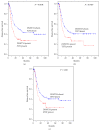Molecular Mutations and Their Cooccurrences in Cytogenetically Normal Acute Myeloid Leukemia
- PMID: 28197208
- PMCID: PMC5288537
- DOI: 10.1155/2017/6962379
Molecular Mutations and Their Cooccurrences in Cytogenetically Normal Acute Myeloid Leukemia
Abstract
Adult acute myeloid leukemia (AML) clinically is a disparate disease that requires intensive treatments ranging from chemotherapy alone to allogeneic hematopoietic cell transplantation (allo-HCT). Historically, cytogenetic analysis has been a useful prognostic tool to classify patients into favorable, intermediate, and unfavorable prognostic risk groups. However, the intermediate-risk group, consisting predominantly of cytogenetically normal AML (CN-AML), itself exhibits diverse clinical outcomes and requires further characterization to allow for more optimal treatment decision-making. The recent advances in clinical genomics have led to the recategorization of CN-AML into favorable or unfavorable subgroups. The relapsing nature of AML is thought to be due to clonal heterogeneity that includes founder or driver mutations present in the leukemic stem cell population. In this article, we summarize the clinical outcomes of relevant molecular mutations and their cooccurrences in CN-AML, including NPM1, FLT3ITD, DNMT3A, NRAS, TET2, RUNX1, MLLPTD, ASXL1, BCOR, PHF6, CEBPAbiallelic, IDH1, IDH2R140, and IDH2R170, with an emphasis on their relevance to the leukemic stem cell compartment. We have reviewed the available literature and TCGA AML databases (2013) to highlight the potential role of stem cell regulating factor mutations on outcome within newly defined AML molecular subgroups.
Conflict of interest statement
The authors declare that they have no competing interests.
Figures

References
-
- Preisler H., Davis R. B., Kirshner J., et al. Comparison of three remission induction regimens and two postinduction strategies for the treatment of acute nonlymphocytic leukemia: a cancer and leukemic group B study. Blood. 1987;69(5):1441–1449. - PubMed
-
- Wiernik P. H., Banks P. L. C., Case D. C., Jr., et al. Cytarabine plus idarubicin or daunorubicin as induction and consolidation therapy for previously untreated adult patients with acute myeloid leukemia. Blood. 1992;79(2):313–319. - PubMed
Publication types
LinkOut - more resources
Full Text Sources
Other Literature Sources
Miscellaneous

